
|
||
|
Portland art blog + news + exhibition reviews + galleries + contemporary northwest art
|
||
Paula Rebsom's Threshold at Marylhurst 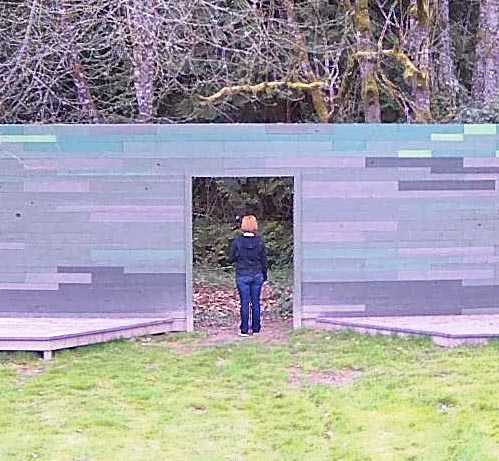 Detail of Paula Rebsom's THRESHOLD There is a group of often Portland based artists who are all interested in the way design reveals the animal quotient in viewers. It is an art of interlocution, where design language is bait and therefore the presence of man directs and distills the gaze into a simultaneously concentrated and shattered perception. It is related to design, minimalism, technology and the light & space movement... but often it is more about creating an incomplete parallel reality experience of heightened senses and awareness of how space is used and negotiated (I call this perceived negotiation of space vection). All use a kind of abbreviated or provisional architecture (even digital), instead of a fully immersive built environment it differs from design in that resolution is avoided at all costs as if the brain itself has been hacked. Instead of being ad-hoc like say a pavilion by an architect, a trade show booth or an art installation contained within a gallery it is more like a perceptual spider web, quite intentionally set like benign trap to expand space into multifaceted or even quantum polyspatium. In a way it is far more surreal psychic incursion than design or old school minimalism tends to be because it engages and partially shatters the animal logic that is required to negotiate the art. Where Robert Irwin and James Turrell were literally using science to isolate and intensify the visual experience these artists use design, light, line and other technology to renegotiate the viewer's perceptual engagement in an active matrix that has a lot of additional information imbedded into it. It is similarly reductive but is more associative than the minimalists and light and space artists. The group (actually many groups) is well known to Portlanders and an incomplete list includes; Damien Gilley, Laura Hughes, Jordan Tull, Avantika Bawa, Alex Mackin Dolan, Jenene Nagy, Dan Anderson & Chrsis held (Von Tundra), Josh Smith, Jesse Hayward, Zachary Davis, Myself, Paula Rebsom and Laura Fritz among others. Since Portland is a city reinventing with an intense natural/built/technology environment intermix, it attracts these sorts of artists. Most have a history of exhibiting together in group shows that have not obliquely pointed out this connection and there has there has never been a show looking specifically at the genre. Instead, everyone seems to be perusing international level shows outside of their frequent home base city, Portland Oregon. Perhaps they purposefully want decentralized exhibitions in a manner befitting their interest in shattering the perception of space and single animal consciousness into a kind of pan dimensional expansion of cognitive real-estate? Quantum Perception? One of the most interesting recent projects within this genre is Paula Rebsom's THRESHOLD: Surveying the Domestic Wild recently installed on the Marylhurst University campus and funded by RACC. The work consists of a porch-like terraced 50 ft green wall with viewing slits and one doorway situated on the edge of the quad and the woods behind. It uses the design language of both a hunting blind, digital pixels(to signify surveillance) and a back yard patio enclosure. The doorway is placed directly in front of a deer trail and a motion sensitive day and night time camera is trained in the threshold the doorway creates. Eventually it will stream real time motion detected video but right now it posts snapshots every ten seconds. What results is a lot of waiting and some interesting moments like a coyote appearing just before a human then returning just after she left. Here is an interesting sequence spanning 40 seconds: 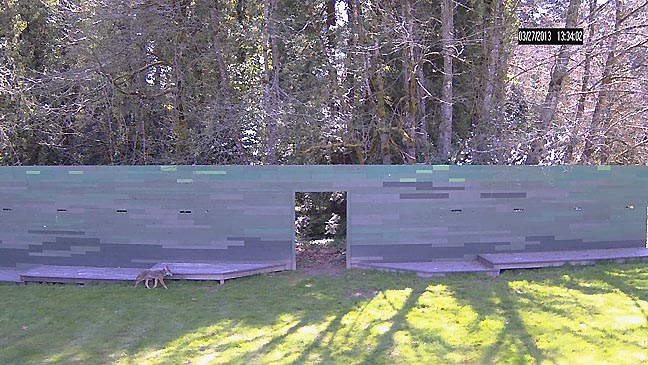
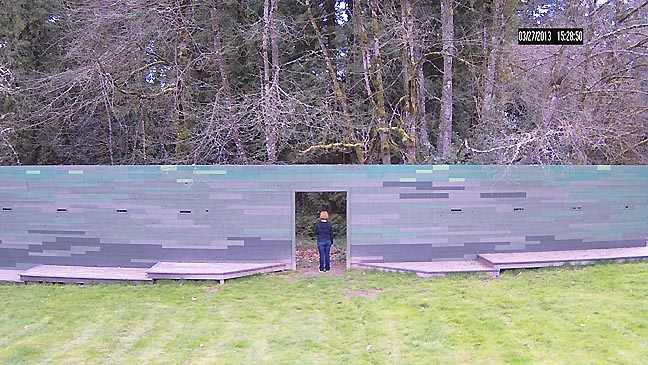
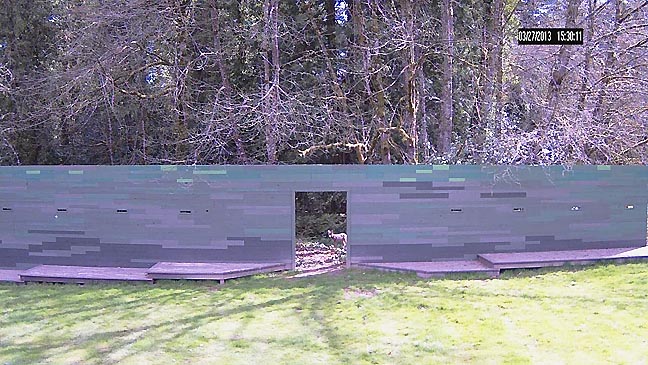
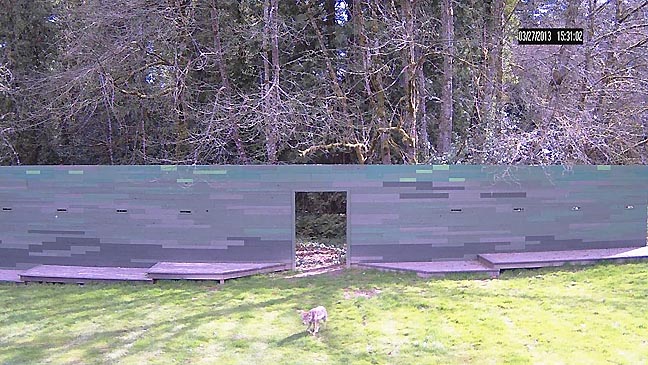
The still images suggest a narrative but their incomplete perspective we don't know if the woman was reacting to the coyote or not? For example, the coyote was clearly aware of the woman and used the art piece as blind... suggesting that perhaps it is more adapted to this environment than the humans? Thus, rather than an egoistic human promulgation of edifice as art it is the animal use of the design element that activates the piece. This is an exciting proposition as previous art walls are far more about monolithic spatial occupation. This is something new as the old style... most notably Richard Serra's Tilted Arc, was found to be a nuisance because they obstructed human break time behaviors. In Rebsom's case, the animal that most fully apprehends and exploits the piece is arguably the coyote not the human. Also, in the case of the Tilted Arc one could infer that the humans were the nuisance! In this case an animal often considered a nuisance completes the piece as the digital panopticon records the proceedings. Other artists like Mary Miss have used the language of architecture but the effect is so much more controlling, intended just for humans and less open-ended. 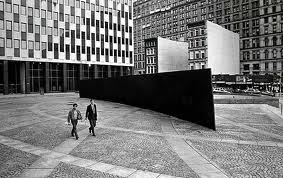
Tilted Arc, Richard Serra, 1981, sculpture, steel, New York City (destroyed). Photo (c) 1985 David Aschkenas I love the way this shatters the single species perspective though the additional layer of digital surveillance undermines the coyote's guile. Thus technology confirms the human species its planet overseer status... or is all of this surveillance a trap of our own making? Rebsom is really onto something here and I can see how much lower profile design incursions into the wild might yield even more interesting results. My point being art that which reveals the limits and urges to expand human perception are some of the most worthwhile avenues for contemporary art today. Overall, we as a species are becoming more accepting of such surveillance... which makes me wonder, will the coyotes evolve countermeasures? Posted by Jeff Jahn on April 01, 2013 at 13:20 | Comments (0) Comments Post a comment Thanks for signing in, . Now you can comment. (sign out)
(If you haven't left a comment here before, you may need to be approved by
the site owner before your comment will appear. Until then, it won't appear
on the entry. Thanks for waiting.)
|
| s p o n s o r s |
 |
 |
 |
 |
 |
 |
 |
 |
 |
 |
 |
 |
 |
 |
 |
 |

|
Site Design: Jennifer Armbrust | • | Site Development: Philippe Blanc & Katherine Bovee | |

